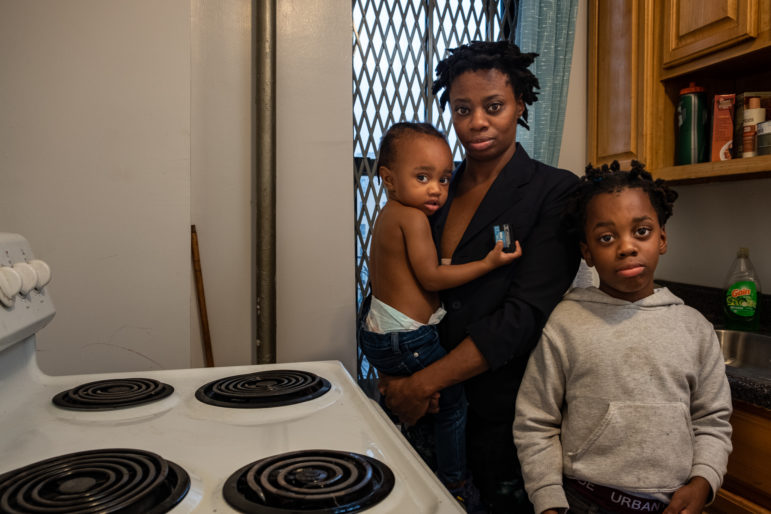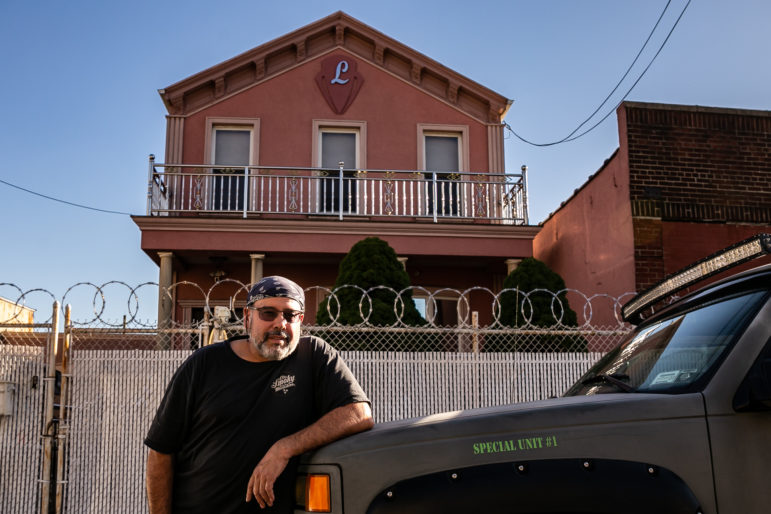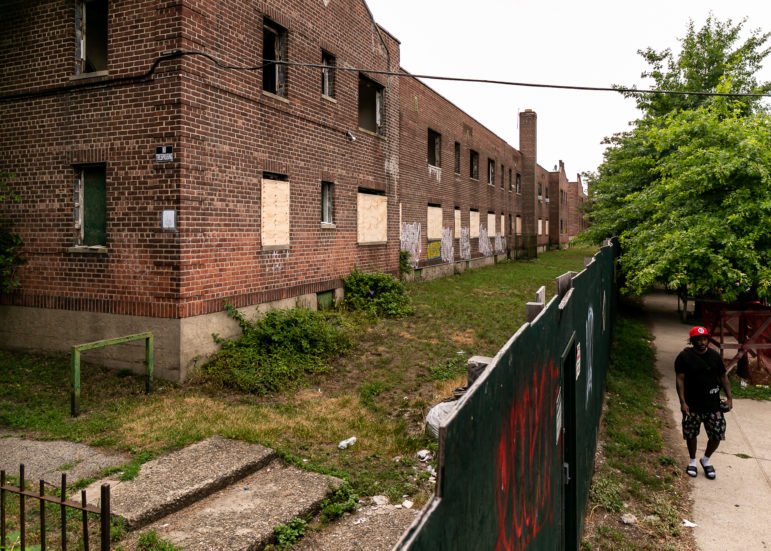It’s been an eventful year in New York City housing. Mayor Eric Adams launched a new plan for housing production and a controversial approach to street homelessness. At the same time, the city’s homeless shelter population reached historic highs this year, fueled in part by an increase in migrants from the southern border and by soaring rent costs, including the biggest price hike for rent-stabilized apartments in nearly a decade.

Adi Talwar
Choice Scott in her kitchen with her children in their former supportive housing apartment in The Bronx, pictured here in February 2022. Scott is one of thousands of tenants living in the city’s network of “scattered site” supportive housing, many of whom endure poor housing conditions.
It’s been an eventful year in New York City housing. Mayor Eric Adams took the helm of City Hall at the start of the 2022, launching a new plan for housing production and a controversial approach to street homelessness. The city’s homeless shelter population reached historic highs this year, fueled in part by an increase in migrants from the southern border and by soaring rent costs, including the biggest price hike for rent-stabilized apartments in nearly a decade.
As City Limits looks to expand our coverage of New York City housing and homelessness in the year ahead, we’re looking back at 2022. Below are the 10 most-read housing stories we published over the the last 12 months.
What should we cover in 2023? Send story tips here.
City Limits’ Most-Read Housing Stories in 2022
10. NY Lawmakers Propose $250M to Launch Section 8-style Rent Subsidy
During budget negotiations this spring, lawmakers in the State Senate and Assembly included a quarter of a billion dollars to fund the Housing Access Voucher Program (HAVP), which would provide a new rent voucher for New Yorkers experiencing homelessness or at risk of homelessness, including undocumented immigrants. Though both progressive tenant organizations and landlord interest groups supported the legislation, Gov. Kathy Hochul declined to fund it in the final budget deal and the bill failed to pass during the legislative session that wrapped up in June. But housing advocates are still pushing to revive HAVP in 2023, with more than 80 organizations signing a letter to the governor this month urging her to establish and fund the program, which would cover a portion of a participant’s rent up to 30 percent of their household income.
9. Hochul, Lawmakers Look to Override NY’s Exclusionary Zoning Amid Housing Crunch
In the never-ending YIMBY vs. NIMBY debate, accessory dwelling units (ADUs) took center stage in 2022, including in the primary for governor. Gov. Kathy Hochul backed a plan to legalize ADUs—extra apartments in basements, attics or garages—in lots zoned for single-unit homes. Supporters say the move would ease the state’s affordable housing shortage and help address decades of exclusionary zoning rules rooted in racism and segregation. But the plan was vehemently opposed by Hochul’s more moderate democratic rival in the primary and her Republican competitor in the general election, both of whom argued the policy would strip local governments of a say in neighborhood zoning rules.

Adi Talwar
Nelson Llorens in front of his East New York home on Glenmore Avenue. Developers have regularly approached him and offered to buy his property, he says, though he is holding out for the highest offer he can get.8. House Flippers Continue to Target East New York. Residents Blame the 2016 Rezoning
House flipping remains rampant in East New York, a transit-rich neighborhood with thousands of two- to four-family homes. Home prices in the predominantly Black and Latino neighborhood began to tick up before then-Mayor Bill de Blasio announced his plans to rezone 190 blocks of East New York in 2014, analyses showed. But affordable housing advocates and local residents say de Blasio’s plan, approved by the City Council in 2016, only drove more investors to scoop up homes, jack up prices and push out existing residents. “Speculators come by every day, every hour,” one community leader said. “They see a lot of poor people on valuable land.”
7. Tracking the Number of People in NYC Homeless Shelters in 2022
Finding out just how many people send each night in a New York City homeless shelter is a complicated question. The city’s Department of Homeless Services publishes a figure daily, but it’s not a complete picture of the system, which is run by four different agencies, most of which have no obligation to publish a daily census. In an effort to more accurately capture the scope of the city’s homelessness crisis, City Limits began tracking population numbers across the various agencies that operate shelter beds—numbers that have grown to record highs this year—and will continue to do so in 2023. Our Shelter Count project was the subject of a feature article in the New Yorker in July.
6. Mayor’s Budget Plan Cuts $615M from Homeless Services, as Subway Crackdown Intensifies
Debate over spending on housing and homeless services dominated the city’s budget negotiations this year. Shelter providers urged City Hall to hire more workers to help move people more quickly into permanent housing, especially as Mayor Eric Adams intensified an initiative to remove homeless New Yorkers from subway cars and public spaces. While the mayor later added $5 billion to the city’s 10-year capital housing plan, his final budget package was still short of the $4 billion a year dedicated to housing he pledged to commit while running for office.
5. East New York Families in Limbo as Developer Plans High Rise to Replace Crumbling Housing Complex

Adi Talwar
Boarded up windows at Arlington Village in Brooklyn.
This story, produced in collaboration with news site THE CITY, took a look at the Arlington Village apartment complex in East New York, where just six apartments out of hundreds were still occupied this summer as the property owner looks to rezone and develop the site, once a vibrant community that’s now largely boarded up. “It’s discouraging,” one longtime tenant told City Limits this summer. “The way they have the building just abandoned—anything can happen.”
4. As NY’s Eviction Moratorium Nears its End, Will Albany Pass ‘Good Cause’ Bill?
The Good Cause Eviction bill emerged as a key demand of many tenants’ rights advocates this year, while landlord groups launched an aggressive campaign to kill the measure. The legislation would have given tenants in non-rent stabilized apartments some of the same rights as tenants in rent-regulated units: Granting them a lease renewal in most cases, capped rent increases and requiring property owners to prove “good cause”—like nonpayment—to kick them out. Local municipalities across the state, including Newburgh and Kingston, have passed similar measures this year, and the statewide version is likely to once again be the center of legislative debate in Albany in 2023.
3. ‘It’s Like a Slum’: Supportive Housing Tenants Cope with Violation-Filled Homes. Provider Blames Underfunding
Egregious, unsafe conditions plague New York City’s network of scattered-site supportive housing, where nonprofit providers with government contracts rent units in privately-owned buildings and sublease them to formerly homeless New Yorkers with mental illness, HIV/AIDS and other special needs. They include Postgraduate Center for Mental Health, which receives millions of dollars in contracts from the state to operate around 540 units of scattered-site supportive housing. City Limits identified 32 buildings where Postgraduate Center rents these apartments and found they accounted for 1,433 open housing code violations as of July 2022, and nearly half of the buildings are owned by people who have appeared on the public advocate’s annual Worst Landlords List. Postgraduate and other providers blame the state’s low contract rates, which they say forces them to rent units wherever they can find them.

Adi Talwar
Choice Scott in her kitchen with her children in their former supportive housing apartment in The Bronx, pictured here in February.
2. Bronx Rental Complex Must Accept Housing Vouchers, Judge Rules
This summer, a Manhattan Supreme Court justice sided with a 34-year-old mother of two who sued the owners of roughly 6,300 apartments the Bronx’s Parkchester complex in the eastern Bronx after she was denied an apartment because she did not earn at least $62,000 a year, even though the CityFHEPS voucher she received from the city would cover the full rent. It is a violation of the city’s human rights law for landlords to deny apartments to applicants because they use government subsidies to pay their rent, and the Parkchester decision marked the first time a New York court has ruled that minimum-income policies for people with full-rent subsidies violate city and state laws, said Housing Works senior attorney Armen Merjian, who represented the family in the lawsuit.
1. NYC’s New Housing Voucher Rules Will Drastically Expand Income Eligibility for Renewals
In October, the city approved a new rule that enabled New Yorkers who receive CityFHEPS rental assistance to hold onto their housing vouchers after five years if they earn up to 80 percent of Area Median Income—currently $66,880 for an individual or $85,920 for a family of three. The decision marks a significant adjustment to a new law that increased the value of CityFHEPS vouchers but capped renewal eligibility at 250 percent of the federal poverty line—equal to just $32,200 for a single adult and just under $55,000 for a family of three. That strict income cap would lead to problems down the road, advocates argued, forcing families to choose between a job that pays a living wage or their housing voucher. “It’s a really, really, really big win,” Sarah Wilson, an organizer with the Urban Justice Center’s Safety Net Project, said of the October rule change to prevent that. “You can take a job that pays $20 an hour and not risk losing your housing.”









One thought on “City Limits’ Most-Read Housing Stories in 2022”
It’s a really, really, really big win.